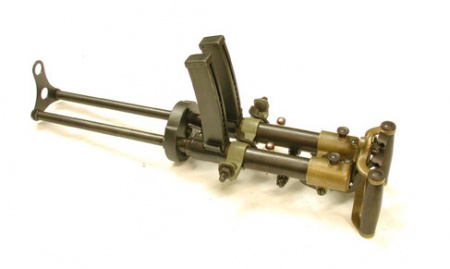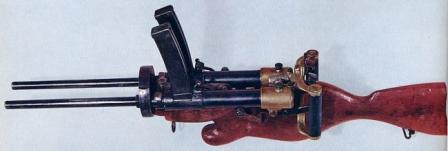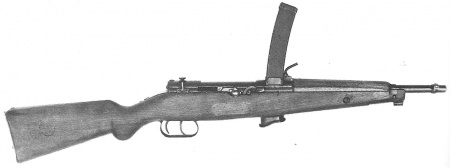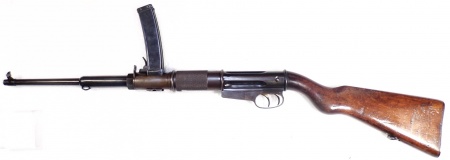| If you have been locked out of your account you can request a password reset here. |
Villar Perosa M1915
The Villar Perosa M1915 (also known as the Revelli Automatic Machine Gun) is a twin-barreled submachine gun of Italian manufacturer Officine Villar Perosa (OVP in short). It was originally designed in 1914 by famous Italian small arms designer Bethel Abiel Revelli. It was used by cyclist troops fitted to their bicycles, and also fitted to some Italian aircrafts. In 1915, the Villar Perosa was adapted for infantry use, with the introduction of a variety of mountings, including carrying trays (which were carried on shoulder straps or put on the ground for more stable position and less exposure to enemy fire) and light tripods. Later, a wooden rifle-type stock was designed for the Villar Perosa, so it could be fired more or less comfortably from the shoulder, thus creating the first practical submachine gun in the world. Little known, but the Austrian army were impressed enough by these double-barreled designs to produce a some number of their own copies in 1917, under the designation "Sturmpistole".
The first attempt at conversion into a full-fledged submachine gun was made by Fiat and OVP (then a joint venture) back in 1916, but the idea was not actively developed until 1918. A slightly improved version of the same design was later developed by Beretta, and was known as the Beretta M1918. Thus, the Villar Perosa is not only, practically, the first submachine gun in the world, but also the beginning of Beretta's submachine gun traditions. Around the same time, Villar Perosa created a new single-receiver version, with a simpler metal frame, equipped with a rifle-type stock and two triggers. This weapon were known as "Moschetto Automatico Revelli"; in the media they are usually referred to as O.V.P. M1918 or Villar Perosa M1918 (as done by Villar Perosa).
As the original Villar Perosa SMGs are rare and can hardly be seen outside of museums, movie productions have made Villar Perosa mock-ups from later Beretta submachine guns.
Villar Perosa M1915 SMG and variants can be seen in the following films, television series, video games, and anime used by the following actors:
Villar Perosa M1915
Specifications
(1914–1918)
- Type: Submachine gun
- Calibers: 9x19mm Glisenti, 9x23mm Steyr (Steyr-Skoda copy)
- Weight: 14lb (6.5 kg) (sans mount)
- Length: 35 in (900 mm)
- Barrel length: 11 in (279 mm)
- Capacity: 2 x 25 rounds
- Fire Modes: Full-Auto only
Video Games
| Game Title | Appears as | Mods | Release Date |
|---|---|---|---|
| Battlefield: 1918 | Villar-Perosa | 2010 |
Beretta M1918
The Beretta M1918 was an improved, single-receiver version of the Villar Perosa M1915, designed by Tullio Marengoni. Multiple versions of the M1918 exist, the most common version was the single-trigger semi-auto-only "Monogrillo" model. Another version was the twin-trigger "Bigrillo" model, which allowed for full-auto fire by pulling on its rear trigger.
Several sources claimed that the M1918 was the first purpose-built SMGs ever issued (the Villar Perosa being discounted due to its doctrinal origins as a mounted light support weapon), predating even the issue of the Bergmann MP18; however this claim has been disputed as it is unclear if the rarer full-auto "Bigrillo" model (i.e. the model that is actually an SMG by definition) actually reached the frontlines, and a lack of primary sources on the M1918's WWI use made some experts believe that the M1918 may have never been issued in WWI at all.
Subsequently, was introduced a modernized semi-automatic carbine variant, the M1918/30 (aka MAB 18/30), specially designed for use by the police. This used a bottom loading magazines, that was originally tested already in 1918, but was rejected then, apparently due to the biggest convenience of top-loading in WWI conditions. Further development of the design led to the appearance of the Beretta MAB 38.
Specifications
(1918 - 1920)
- Type: Carbine ("Monogrillo"); Submachine gun ("Bigrillo")
- Calibers: 9x19mm Glisenti
- Weight: 7lb 3oz (3.3 kg)
- Length: 43 in (1092 mm)
- Barrel length: 12in (305 mm)
- Capacity: 25 rounds
- Fire Modes: Semi-auto ("Monogrillo"); Semi-auto/full-auto ("Bigrillo")
Video Games
| Game Title | Appears as | Mods | Notations | Release Date |
|---|---|---|---|---|
| Battlefield 1 | Automatico M1918 | "Monogrillo" depicted as firing in full auto | 2016 |
OVP M1918
An later/after-war modifying an isolated M1915 receiver into an infantry-portable weapon, officially known as "Moschetto Automatico Revelli"/"Revelli Automatic Rifle". Not to be confused with the more early Fiat-OVP M1916 prototype. Although they are usually labeled "M1918", and some sources describe as tested already in early 1917, it seems that main production did not began until the 1920s.
As with the Beretta, WWI use is controversial; there are allegations that only about 500 were produced before the end of the war, and were only used to a limited extent by aviators. Since this data has not yet been fully verified, it may be the designated Fiat M1916, which could definitively define Revelli as a post-war design. OVP will be produced later in the 1920s, with limited use in subsequent conflicts as early as the 1930s.
Specifications
(1917 - 1918 (?), 1921 - 1929)
- Type: Submachine gun, Carbine (single trigger)
- Caliber: 9x19mm Glisenti
- Weight: 8.09lb (3.67 kg)
- Length: 35.43 in (900 mm)
- Barrel length: 11.02 in (280 mm)
- Capacity: 25 rounds
- Fire Modes: Semi-Auto/Full-Auto (dual triggers), Semi-Auto (sinlge trigger)
Video Games
| Game Title | Appears as | Mods | Release Date |
|---|---|---|---|
| Sniper Elite 4 | 2017 |





